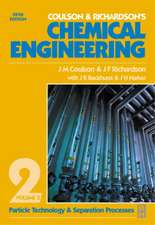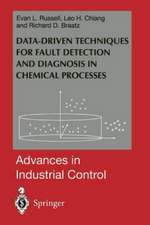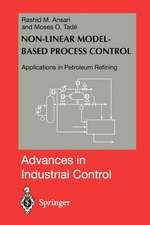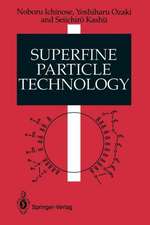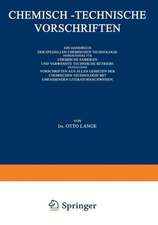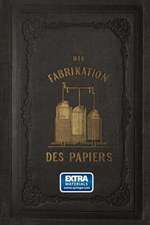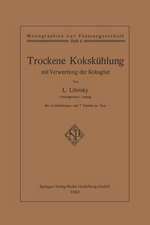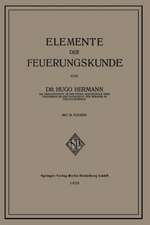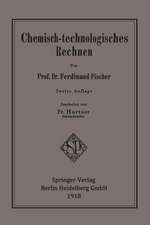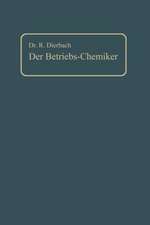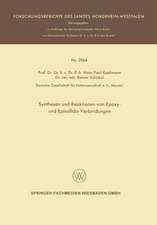Process Control: Theory and Applications
Autor Jean-Pierre Corriouen Limba Engleză Hardback – 21 apr 2004
Progressively it introduces concepts of increasing difficulty, allowing a less brutal tuition of theories and control methods. For each topic, the theories, techniques and algorithms are presented in detail, with numerous references. The consideration of the same problems by different approaches will provoke a deep understanding. It includes all necessary explanations for your complete understanding of the subject and examples that you can reproduce to master the different techniques. Broad coverage creates an important synthesis on the majority of aspects of control giving you a complete view of control theory and possible applications within the field. Different levels of reading are possible, opening this powerful source of information to students, engineers, academics and researchers alike.
| Toate formatele și edițiile | Preț | Express |
|---|---|---|
| Paperback (2) | 622.35 lei 38-45 zile | |
| Springer International Publishing – 9 sep 2018 | 622.35 lei 38-45 zile | |
| SPRINGER LONDON – 12 oct 2010 | 1107.46 lei 38-45 zile | |
| Hardback (2) | 834.00 lei 38-45 zile | |
| Springer International Publishing – sep 2017 | 834.00 lei 38-45 zile | |
| SPRINGER LONDON – 21 apr 2004 | 1243.78 lei 6-8 săpt. |
Preț: 1243.78 lei
Preț vechi: 1516.80 lei
-18% Nou
Puncte Express: 1866
Preț estimativ în valută:
238.01€ • 254.50$ • 198.44£
238.01€ • 254.50$ • 198.44£
Carte tipărită la comandă
Livrare economică 18 aprilie-02 mai
Preluare comenzi: 021 569.72.76
Specificații
ISBN-13: 9781852337766
ISBN-10: 1852337761
Pagini: 780
Ilustrații: XX, 752 p.
Dimensiuni: 156 x 234 x 47 mm
Greutate: 1.19 kg
Ediția:2004
Editura: SPRINGER LONDON
Colecția Springer
Locul publicării:London, United Kingdom
ISBN-10: 1852337761
Pagini: 780
Ilustrații: XX, 752 p.
Dimensiuni: 156 x 234 x 47 mm
Greutate: 1.19 kg
Ediția:2004
Editura: SPRINGER LONDON
Colecția Springer
Locul publicării:London, United Kingdom
Public țintă
ResearchCuprins
1 Dynamic Modelling of Chemical Processes.- 2 Linear Feedback Control.- 3 Stability Analysis.- 4 Design of Feedback Controllers.- 5 Frequency Analysis.- 6 Improvement of Control Systems.- 7 State Representation, Controllability and Observability.- 8 Multivariable Control by Transfer Function Matrix.- 9 Discrete-Time Generalities and Basic Signal Processing.- 10 Identification Principles.- 11 Models and Methods for Parametric Identification.- 12 Parametric Estimation Algorithms.- 13 Digital Control.- 14 Optimal Control.- 15 Generalized Predictive Control.- 16 Model Predictive Control.- 17 Nonlinear Geometric Control.- 18 State Observers.- 19 Nonlinear Control of Reactors with State Estimation.- 20 Distillation Column Control.- 21 Examples and Benchmarks of Typical Processes.
Textul de pe ultima copertă
A wide range of identification and control methods applicable to processes are accompanied by typical comparable examples, encouraging you to make comparisons.
The initial classical approach to continuous control by transfer functions will be of enormous benefit, whether you are a student beginning in control or an engineer in industry who, up until now, has only had a land contact with control. The more advanced material on discrete control and the state space control, as well as nonlinear control and observers, requires minimal previous knowledge, allowing you to make better use of performing techniques.
•Progressively introduces concepts of increasing difficulty, allowing a less brutal tuition of theories and control methods.
• For each topic, the theories, techniques and algorithms are presented in detail, with numberous references.
• The consideration of the same problems by different approaches will provoke a deep understanding.
• All necessary explanations for your complete understanding of the subject.
• Examples that you can reproduce to master the different techniques.
Broad coverage creates and important synthesis on the majority of aspects of control that gives you a complete view of control theory and possible applications within the field. Different levels of reading are possible, opening this powerful source of information to students, engineers, academics and researchers alike.
The initial classical approach to continuous control by transfer functions will be of enormous benefit, whether you are a student beginning in control or an engineer in industry who, up until now, has only had a land contact with control. The more advanced material on discrete control and the state space control, as well as nonlinear control and observers, requires minimal previous knowledge, allowing you to make better use of performing techniques.
•Progressively introduces concepts of increasing difficulty, allowing a less brutal tuition of theories and control methods.
• For each topic, the theories, techniques and algorithms are presented in detail, with numberous references.
• The consideration of the same problems by different approaches will provoke a deep understanding.
• All necessary explanations for your complete understanding of the subject.
• Examples that you can reproduce to master the different techniques.
Broad coverage creates and important synthesis on the majority of aspects of control that gives you a complete view of control theory and possible applications within the field. Different levels of reading are possible, opening this powerful source of information to students, engineers, academics and researchers alike.
Caracteristici
Presents, for the first time in a single book, most of the aspects of control that can help anyone to have a synthetic view of control theory and its process-industrial applications Includes supplementary material: sn.pub/extras
Notă biografică
Jean-Pierre Corriou is an author of three books: Commande des Procédés, Lavoisier, Paris, 766 pages (three editions, 3rd 2012), Process Control, Theory and application, Springer, London, 2004, 752 pages, and Méthodes numériques et optimisation, Lavoisier, Paris, 2010, 442 pages. He is also author of 106 articles in national and international journals, as well as a reviewer for many journals, and an associate editor in the International Journal of Chemical Engineering and Mathematical Methods in Engineering.
Descriere
Descriere de la o altă ediție sau format:
In Process Control, a wide range of identification and control methods applicable to processes are accompanied by typical comparable examples, encouraging you to make comparisons.
The initial classical approach to continuous control by transfer functions will be of enormous benefit, whether you are a student beginning in control or an engineer in industry who, up until now, has only had a superficial or empirical contact with control. The more advanced material on discrete control and state-space control, as well as nonlinear control and observers, requires minimal previous knowledge, allowing you to make better use of techniques with proven performance.
• Introduces concepts of progressively increasing difficulty, smoothing the path to learning the more advanced theories and control methods.
• For each topic, the theories, techniques and algorithms are presented in detail, with numberous references.
• The comparative consideration of different approaches to similar problems deepens your understanding.
• Examples that you can reproduce to master the different techniques.
Broad coverage creates an important synthesis of the spectrum of control theory and its process-industry-related applications. Different levels of reading are possible, opening this powerful source of information to engineers, academics, researchers and students alike.
In Process Control, a wide range of identification and control methods applicable to processes are accompanied by typical comparable examples, encouraging you to make comparisons.
The initial classical approach to continuous control by transfer functions will be of enormous benefit, whether you are a student beginning in control or an engineer in industry who, up until now, has only had a superficial or empirical contact with control. The more advanced material on discrete control and state-space control, as well as nonlinear control and observers, requires minimal previous knowledge, allowing you to make better use of techniques with proven performance.
• Introduces concepts of progressively increasing difficulty, smoothing the path to learning the more advanced theories and control methods.
• For each topic, the theories, techniques and algorithms are presented in detail, with numberous references.
• The comparative consideration of different approaches to similar problems deepens your understanding.
• Examples that you can reproduce to master the different techniques.
Broad coverage creates an important synthesis of the spectrum of control theory and its process-industry-related applications. Different levels of reading are possible, opening this powerful source of information to engineers, academics, researchers and students alike.



